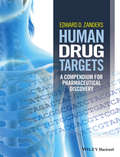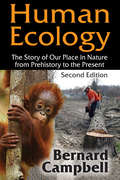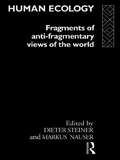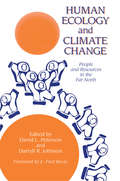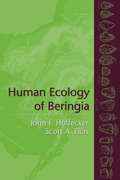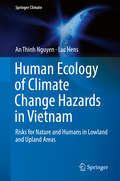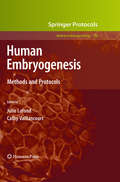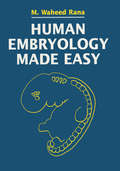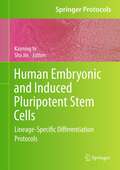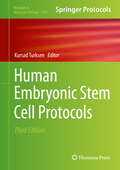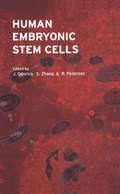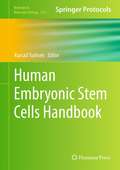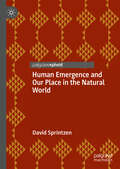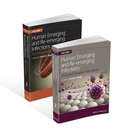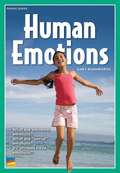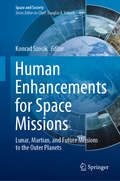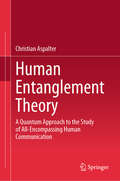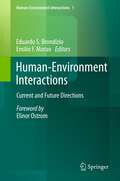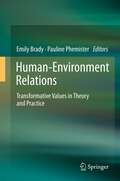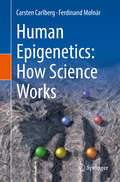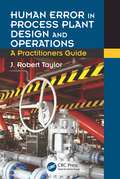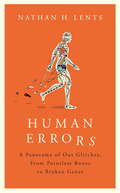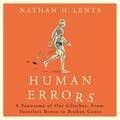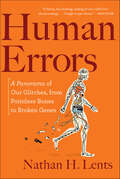- Table View
- List View
Human Drug Targets
by Edward D. ZandersThe identification of drug targets in a given disease has been central to pharmaceutical research from the early days of pharmacology right up to the modern genomics era. Human Drug Targets provides an essential guide to one of the early most important aspects of drug discovery - the identification of suitable protein and RNA targets prior to the creation of drug development candidates. The first part of the book consists of introductory chapters that provide the background to drug target discovery and highlight the way in which these targets have been organised into online databases. It also includes a user's guide to the list of entries that forms the bulk of the book. Since this is not designed to be a compendium of drugs, the emphasis will be on the known (or speculated) biological role of the targets and not on the issues associated with pharmaceutical development. The objective is to provide just enough information to be informative and prompt further searches, while keeping the amount of text for each of the many entries to a minimum. Human Drug Targets will prove invaluable to those drug discovery professionals, in both industry and academia, who need to make some sense of the bewildering array of online information sources on current and potential human drug targets. As well as creating order out of a complex target landscape, the book will act as an ideas generator for potentially novel targets that might form the basis of future discovery projects.
Human Ecology: The Story of Our Place in Nature from Prehistory to the Present
by Bernard CampbellThis new edition of a widely adopted primary and supplementary text explores human adaptations to environments over time. It is biologically and culturally sophisticated, drawing on an impressive array of archaeological and paleontological research. Campbell proceeds from earlier, simpler biomes to later, more complex ones, examining selected aspects of the prehistory and history of the human species. Human Ecology offers a succinct introduction to the history of these adaptations within ecosystems: a shared concern among anthropologists, biologists, environmentalists, and the general reader.In the years since this book was first published, the problems that the human species has faced have become more serious. As predicted, world population has rapidly increased, and with it starvation, malnutrition, and disease. Our precious environment is being devastated. In particular, the tropical rain forests, our richest resource, are being cut and burned at an alarming rate with the accompanying degradation of the forest soils. Their flora and fauna, including their human inhabitants, are being destroyed. All this is being done for short-term financial gain without any long-term planning or understanding of the risks involved.There are no simple and humane short-term solutions to the central problem of increasing population pressure. In the long-term, the only hope of making possible a life of quality for all, rather than a life of starvation and squalor, is through education. It is essential that we understand the limits that exist to the earth's productivity and the overriding importance of maintaining richly diversified fauna and flora. If we understand how we arrived at this life-threatening situation, the resolution will become clear. Non-violent and viable solutions do exist and can be implemented, but the human race first must understand and face up to the nature of its frightening predicament.
Human Ecology: Fragments Of Anti-fragmentary Views Of The World
by Dieter Steiner Markus NauserWe face an environmental catastrophe of global proportions. The ecological rationality of modern society, and of science in particular, is in question. Science still responds to crises at the level of technocratic expertise, and still treats society as an adaptive system. By bringing together a number of integrative approaches to the human-environment problem, Human Ecology shapes a more radical, fundamental agenda for change. The book creates a framework for a cohesive discourse, for a "new human ecology". From the notion that the individual person is an agent mediating between society and environment, the individual contributors recognize that the environmental crisis is really a crisis of society - manifesting itself in an increasing fragmentation of lives in general and knowledge in particular. Arguing for environmentally sustainable lifestyles, the book envisages a new kind of consciousness and a new environment.
Human Ecology And Climatic Change: People And Resources In The Far North
by David L. Peterson Darryll R. JohnsonThe Far North, a land of extreme weather and intense beauty, is the only region of North America whose ecosystems have remained reasonably intact. Humans are newcomers there and nature predominates. As is widely known, recent changes in the Earth's atmosphere have the potential to create rapid climatic shifts in our life-time and well into the future. These changes, a product of southern industrial society, will have the greatest impact on ecosystems at northern latitudes, which until now have remained largely undisturbed. In this fragile balance, as terrestrial and aquatic habitats change, animal and human populations will be irrevocably altered.
Human Ecology of Beringia
by John Hoffecker Scott EliasTwenty-five thousand years ago, sea level fell more than 400 feet below its present position as a consequence of the growth of immense ice sheets in the Northern Hemisphere. A dry plain stretching 1,000 miles from the Arctic Ocean to the Aleutians became exposed between northeast Asia and Alaska, and across that plain, most likely, walked the first people of the New World. This book describes what is known about these people and the now partly submerged land, named Beringia, which they settled during the final millennia of the Ice Age.Humans first occupied Beringia during a twilight period when rising sea levels had not yet caught up with warming climates. Although the land bridge between northeast Asia and Alaska was still present, warmer and wetter climates were rapidly transforming the Beringian steppe into shrub tundra. This volume synthesizes current research-some previously unpublished-on the archaeological sites and rapidly changing climates and biota of the period, suggesting that the absence of woody shrubs to help fire bone fuel may have been the barrier to earlier settlement, and that from the outset the Beringians developed a postglacial economy similar to that of later northern interior peoples.The book opens with a review of current research and the major problems and debates regarding the environment and archaeology of Beringia. It then describes Beringian environments and the controversies surrounding their interpretation; traces the evolving adaptations of early humans to the cold environments of northern Eurasia, which set the stage for the settlement of Beringia; and provides a detailed account of the archaeological record in three chapters, each of which is focused on a specific slice of time between 15,000 and 11,500 years ago. In conclusion, the authors present an interpretive summary of the human ecology of Beringia and discuss its relationship to the wider problem of the peopling of the New World.
Human Ecology of Climate Change Hazards in Vietnam: Risks for Nature and Humans in Lowland and Upland Areas (Springer Climate)
by An Thinh Nguyen Luc HensThis book analyzes climate change associated effects in the mountainous and coastal environments of Vietnam. The scope of the book allows international comparisons to be made between these two affected areas and other similarly affected locations under constant environmental pressure. Frequent and intense climate change hazards are described, along with a wider context of integrated interpretations, socioeconomic implications and policy responses. The book reports on original research combining methodologies from the natural sciences with approaches in human sciences, providing an interdisciplinary human ecological context to analyze similar situations worldwide. The book is structured in four parts. The first part offers background information, and details the human ecological framework. The geography of the analyzed regions is discussed to reflect the environmental and socioeconomic context of Vietnam's coasts and mountains. The second part addresses the coast of Central Vietnam. The effects of tropical storms, floods, rising sea levels and coastal erosion in Ky Anh are studied to highlight the impacts on the local population and its development perspectives. The third part focuses on the uplands of Northern Vietnam. The effects of cyclones, heavy rains, floods, flash floods, and landslides in the Van Chan Mountains are studied to compare the biophysical and socioeconomic impacts. Part four makes policy recommendations in building resilient landscapes and green cities, and discusses the potential implications of findings for practice in Vietnam. The book addresses a wide array of researchers, geography and economics students, consultants and decision makers interested in the actual status and the likely developments on the physical, socioeconomic and mitigation and adaptation attitudes and policies of climate change associated effects.
Human Embryogenesis
by Julie Lafond Cathy VaillancourtDespite its inherent controversy, the exploration of the human embryo can unlock many of the answers to our deepest biological questions. In Human Embryogenesis: Methods and Protocols, internationally recognized researchers contribute detailed methods to analyze various aspects of the embryogenesis process. While comprehensively covering subjects such as the molecular mechanisms of embryonic development, in vitro fertilization, cloning, and the laws and ethical considerations of working with embryos, the volume also addresses critical features of fetal and placental development as well as of uterine biology. Written in the highly successful Methods in Molecular BiologyTM series format, chapters include introductions to their respective topics, lists of the necessary materials and reagents, step-by-step, readily reproducible laboratory protocols, and notes on troubleshooting and avoiding known pitfalls. Authoritative and state-of-the-art, Human Embryogenesis: Methods and Protocols provides a firm foundation for the successful analysis of the embryogenesis process and an easily accessible description of the limitations and advantages of the techniques proposed, certain to aid all those who wish to further unravel the mysteries of human embryogenesis.
Human Embryology Made Easy
by Abdul Hamid RanaThis book is a synopsis of the key facts and concepts of human development. It is intended for students who are taking a human embryology course. The book includes the underlying mechanisms involved in clinically important congenital anomalies that will prove useful to medical and nursing.
Human Embryonic and Induced Pluripotent Stem Cells
by Kaiming Ye Sha JinBecause of the huge potential of human embryonic stem (hES) cells, especially the newly developed human induced pluripotent stem (hiPS) cells, in disease treatment and life quality improvement, enormous efforts have been made to develop new methodologies to translate lab discoveries in stem cell research into bed-side clinical technologies. In Human Embryonic and Induced Pluripotent Stem Cells: Lineage-Specific Differentiation Protocols, experts in the field present a comprehensive collection of protocols designed for labs around the world. The topics covered in this detailed volume include techniques used for maintenance of hES and iPS cells in either small or large scale, techniques for directing hES and iPS cell lineage specification, techniques for enhancing the maturity of differentiated hES and iPS cells within three-dimensional scaffolds, techniques for reprogramming adult cells into iPS cells, techniques for generating patient-specific iPS cells, and techniques for translating hES and iPS cell research into new therapies. Chapters include lab ready protocols with tips on troubleshooting and avoiding known pitfalls. Wide-ranging and authoritative, Human Embryonic and Induced Pluripotent Stem Cells: Lineage-Specific Differentiation Protocols will be a tremendous aid for researchers and students who wish to explore these areas and transform their discoveries into the next generation of regenerative medicine and tissue engineering technologies.
Human Embryonic Stem Cell Protocols
by Kursad TurksenDespite political and ethical controversies surrounding the study of human embryonic stem (hES) cells, new freedoms in regard to using them for research has allowed interest to remain high in understanding the regulatory mechanisms of stem cell self-renewal, their differentiation along various lineages, and their potential use in regenerative medicine. In Human Embryonic Stem Cell Protocols, Second Edition, internationally respected researchers expand upon the popular first edition and describe in detail their most useful techniques for the molecular and cellular manipulation of these intriguing cells. This diverse collection of readily reproducible methods has been optimized for the derivation, characterization, and differentiation of hES cells, with special attention given to regenerative medicine applications. As a volume of the Methods in Molecular BiologyTM series, chapters include brief introductions to their respective topics, lists of the necessary materials and reagents, step-by-step laboratory protocols, and notes on troubleshooting and avoiding known pitfalls. Comprehensive and cutting-edge, Human Embryonic Stem Cell Protocols, Second Edition offers both novice and expert researchers powerful tools essential to understanding the maintenance and differentiation of human embryonic stem cells, as well as their applications in regenerative medicine today.
Human Embryonic Stem Cells
by J. Odorico S. C. Zhang R. PedersenSince the first successful isolation and cultivation of human embryonic stem cells at the University of Wisconsin, Madison in 1998, there has been high levels of both interest and controversy in this area of research. This book provides a concise overview of an exciting field, covering the characteristics of both human embryonic stem cells and pluripotent stem cells from other human cell lineages. The following chapters describe state-of-the-art differentiation and characterization of specific ectoderm, mesoderm and endoderm-derived lineages from human embryonic stem cells, emphasizing how these can be used to study human developmental mechanisms. A further chapter discusses genetic manipulation of human ES cells. The concluding section covers therapeutic applications of human ES cells, as well as addressing the ethical and legal issues that this research have raised.
Human Embryonic Stem Cells Handbook
by Kursad TurksenConsiderable advances have taken place since the initial isolation and characterization of human embryonic stem (HES) cells; however, significant challenges remain before their potential for restoration and regeneration processes in patients can be realized. Understanding the diversity amongst HES cell lines and realizing the ability to isolate lines with robust differentiation potential remain difficult. In the Human Embryonic Stem Cells Handbook, experts in the field provide an assortment of protocols that have been used by various laboratories around the world so as to allow both novices and experienced investigators to compare and contrast different approaches to HES cell isolation and characterization with the hope that, from these protocols, researchers might standardize approaches for HES cell biology. Written in the Methods in Molecular BiologyTM series format, chapters include introductions to their respective topics, lists of the necessary materials and reagents, step-by-step, readily reproducible laboratory protocols, and tips for troubleshooting and avoiding known pitfalls. Authoritative and accessible, Human Embryonic Stem Cells Handbook serves as a valuable reference for scientists pursuing this vital field and its enormous potential.
Human Emergence and Our Place in the Natural World
by David SprintzenThis book challenges the prevailing, though often unacknowledged, view among most practicing scientists and philosophers that human free will is incompatible with the natural causality that is the basic presupposition of modern science. That position is essentially based on the reductionist view of modern physics that all complex phenomena are thought to be ultimately causally explainable solely as a function of the action of their elemental constituents. The book argues that this mainstream opinion is the appropriate logical result of an inadequate conception of the way nature works. To show this the book first details the fundamental philosophical incoherence in the prevailing scientific world view. It then justifies the critique by outlining and re-describing some key findings of modern science, and presents three related alternative aspects by which we can understand the occurrence of natural emergence. In so doing it is suggested that emergence is a pervasive phenomenon in the natural world, and that human free will is an entirely understandable development of these natural processes, when properly understood, in which humanity is appropriately seen as a natural emergent within the evolutionary processes operating in accord with natural selection. Human Emergence and Our Place in the Natural World is essential reading for all philosophers of metaphysics and of science.
Human Emerging and Re-emerging Infections Set
by Sunit K. SinghEmerging and re-emerging pathogens pose several challenges to diagnosis, treatment, and public health surveillance, primarily because pathogen identification is a difficult and time-consuming process due to the "novel" nature of the agent. Proper identification requires a wide array of techniques, but the significance of these diagnostics is anticipated to increase with advances in newer molecular and nanobiotechnological interventions and health information technology. Human Emerging and Re-emerging Infections covers the epidemiology, pathogenesis, diagnostics, clinical features, and public health risks posed by new viral and microbial infections. The book includes detailed coverage on the molecular mechanisms of pathogenesis, development of various diagnostic tools, diagnostic assays and their limitations, key research priorities, and new technologies in infection diagnostics. Volume 1 addresses viral and parasitic infections, while volume 2 delves into bacterial and mycotic infections. Human Emerging and Re-emerging Infections is an invaluable resource for researchers in parasitologists, microbiology, Immunology, neurology and virology, as well as clinicians and students interested in understanding the current knowledge and future directions of infectious diseases.
Human Enhancements for Space Missions: Lunar, Martian, and Future Missions to the Outer Planets (Space and Society)
by Konrad SzocikThis book presents a collection of chapters, which address various contexts and challenges of the idea of human enhancement for the purposes of human space missions. The authors discuss pros and cons of mostly biological enhancement of human astronauts operating in hostile space environments, but also ethical and theological aspects are addressed. In contrast to the idea and program of human enhancement on Earth, human enhancement in space is considered a serious and necessary option. This book aims at scholars in the following fields: ethics and philosophy, space policy, public policy, as well as biologists and psychologists.
Human Entanglement Theory: A Quantum Approach to the Study of All-Encompassing Human Communication
by Christian AspalterThis innovative book has combined the latest drive to integrate the findings and principles of quantum mechanics and quantum technology, especially here quantum computing, into the flamboyant world of social sciences. Starting with Friedrich Nietzsche as a role model, especially his “Human, All-too-Human,” the book explores the world of interpersonal and intrapersonal, intercultural and transhistorical, human communication. This book uses an innovative experiential and abductive research design. The philosophy inspired by Nietzsche meets new inspirations stemming from quantum mechanics and quantum computing in particular. Building on derived guiding principles of (fuzzy) randomness, parallelity, and universality (with communication, words and feelings, as the least common denominator), the book arrives at the formation of a new quantum-inspired theory, called the Theory of Human Entanglement, where entanglements are causal forces for human communication (and hence human actions) that either instigate and propel, or inhibit and stifle human communication (and thus human actions). Human entanglements are diverse; they are complex and accumulative in nature. They operate in a multi-dimensional space, encompassing language usage (including their hidden connotations and culturally constructed truths, such as hidden notions of good and evil, allowed and forbidden), cultural traditions and limitations, governance, institutions, court rulings and practices, particular usages of common sense, local/neighborhood culture and practices, socio-economic and environmental forces and limitations, personal situations and experiences, personal thoughts, feelings, memories and aspirations, and much more. The theory may serve as starting point for greater causality focus in research design and applications across all social sciences and far beyond, especially when dealing with high number or infinite number of potentially causal and causal variables, as well as their aggregate forces (i.e. probability-based vector forces). On top, artificial intelligence applications, quantum information, and quantum finance applications, for example, may contribute to the further development of human entanglement theory, and vice versa.
Human-Environment Interactions
by Emilio F. Moran Eduardo S. BrondízioDrawing on research from eleven countries across four continents, the 16 chapters in the volume bring perspectives from various specialties in anthropology and human ecology, institutional analysis, historical and political ecology, geography, archaeology, and land change sciences. The four sections of the volume reflect complementary approaches to HEI: health and adaptation approaches, land change and landscape management approaches, institutional and political-ecology approaches, and historical and archaeological approaches.
Human-Environment Relations
by Pauline Phemister Emily BradyThis fresh and innovative approach to human-environmental relations will revolutionise our understanding of the boundaries between ourselves and the environment we inhabit. The anthology is predicated on the notion that values shift back and forth between humans and the world around them in an ethical communicative zone called 'value-space'. The contributors examine the transformative interplay between external environments and human values, and identify concrete ways in which these norms, residing in and derived from self and society, are projected onto the environment.
Human Epigenetics: How Science Works
by Carsten Carlberg Ferdinand MolnárThe view “It’s all in our genes and we cannot change it” developed in the past 150 years since Gregor Mendel’s experiments with flowering pea plants. However, there is a special form of genetics, referred to as epigenetics, which does not involve any change of our genes but regulates how and when they are used. In the cell nucleus our genes are packed into chromatin, which is a complex of histone proteins and genomic DNA, representing the molecular basis of epigenetics. Our environment and lifestyle decisions influence the epigenetics of our cells and organs, i.e. epigenetics changes dynamically throughout our whole life. Thus, we have the chance to change our epigenetics in a positive as well as negative way and present the onset of diseases, such a type 2 diabetes or cancer. This textbook provides a molecular explanation how our genome is connected with environmental signals. It outlines that epigenetic programming is a learning process that results in epigenetic memory in each of the cells of our body. The central importance of epigenetics during embryogenesis and cellular differentiation as well as in the process of aging and the risk for the development of cancer are discussed. Moreover, the role of the epigenome as a molecular storage of cellular events not only in the brain but also in metabolic organs and in the immune system is described. The book represents an updated but simplified version of our textbook “Human Epigenomics” (ISBN 978-981-10-7614-8). The first five chapters explain the molecular basis of epigenetics, while the following seven chapters provide examples for the impact of epigenetics in human health and disease.
Human Error in Process Plant Design and Operations: A Practitioner's Guide
by J. Robert TaylorIn contrast to nuclear plants and aerospace systems, human error is largely ignored in quantitative risk assessment for petroleum and chemical plants. Because of this, current risk analysis methods are able to calculate and predict only about one-third of the accidents happening in practice. Human Error in Process Plant Design and Operations: A Pra
Human Errors: A Panorama of Our Glitches, From Pointless Bones to Broken Genes
by Nathan LentsWe like to think of ourselves as highly evolved. But if we are evolution's greatest creation, why are we so badly designed? We have retinas that face backward, we must find vitamins and nutrients in our diets that other animals simply make for themselves and millions of us can't reproduce successfully without help from modern science. And that's just the beginning of the story. Biologist Nathan H. Lents takes us on an entertaining and illuminating tour of our four-billion-year-long evolutionary saga, and shows us how each of our flaws tells us a story about our species' history.
Human Errors: A Panorama of Our Glitches, From Pointless Bones to Broken Genes
by Nathan LentsWe like to think of ourselves as highly evolved creatures. But if we are evolution's greatest creation, why are we so badly designed? We have retinas that face backward, the stump of a tail, and way too many bones in our wrists. We must find vitamins and nutrients in our diets that other animals simply make for themselves. Millions of us can't reproduce successfully without help from modern science. We have nerves that take bizarre paths, muscles that attach to nothing, and lymph nodes that do more harm than good. And that's just the beginning of the story.As biologist Nathan H. Lents explains, our evolutionary history is a litany of mistakes, each more entertaining and enlightening than the last. As we will discover, by exploring human shortcomings, we can peer into our past, because each of our flaws tells a story about our species' evolutionary history.A rollicking, deeply informative tour of our four-billion-year-long evolutionary saga, Human Errors both celebrates our imperfections - for our mutations are, in their own way, a testament to our species' greatness - and offers an unconventional accounting of the cost of our success.Read by L.J. Ganser(p) Tantor Media 2018
Human Errors: A Panorama of Our Glitches, from Pointless Bones to Broken Genes
by Nathan H. LentsA biology professor’s “funny, fascinating” tour of the physical imperfections—from faulty knees to junk DNA—that make us human (Discover). We humans like to think of ourselves as highly evolved creatures. But if we are supposedly evolution’s greatest creation, why do we have such bad knees? Why do we catch head colds so often—two hundred times more often than a dog does? How come our wrists have so many useless bones? Why is the vast majority of our genetic code pointless? And are we really supposed to swallow and breathe through the same narrow tube? Surely there’s been some kind of mistake? As professor of biology Nathan H. Lents explains in Human Errors, our evolutionary history is indeed nothing if not a litany of mistakes, each more entertaining and enlightening than the last. The human body is one big pile of compromises. But that is also a testament to our greatness: as Lents shows, humans have so many design flaws precisely because we are very, very good at getting around them. A rollicking, deeply informative tour of humans’ four-billion-year-and-counting evolutionary saga, Human Errors both celebrates our imperfections and offers an unconventional accounting of the cost of our success.“An insightful and entertaining romp through the myriad ways in which the human body falls short of an engineering ideal—and the often-surprising reasons why.” —Ian Tattersall, author of The Monkey in the Mirror
The Human Essence: The Sources of Science and Art
by George ThomsonThis book is a short introduction to Marxism that addresses its political, historical and ideological aspects of science and art.
